Homemade bread is fluffy, tender, and way better than store-bought loaves. It’s remarkably easy – and fun! – to make with only a few simple ingredients. Try this foolproof white bread recipe with step-by-step instructions and video and you’ll likely never want to buy package bread again.
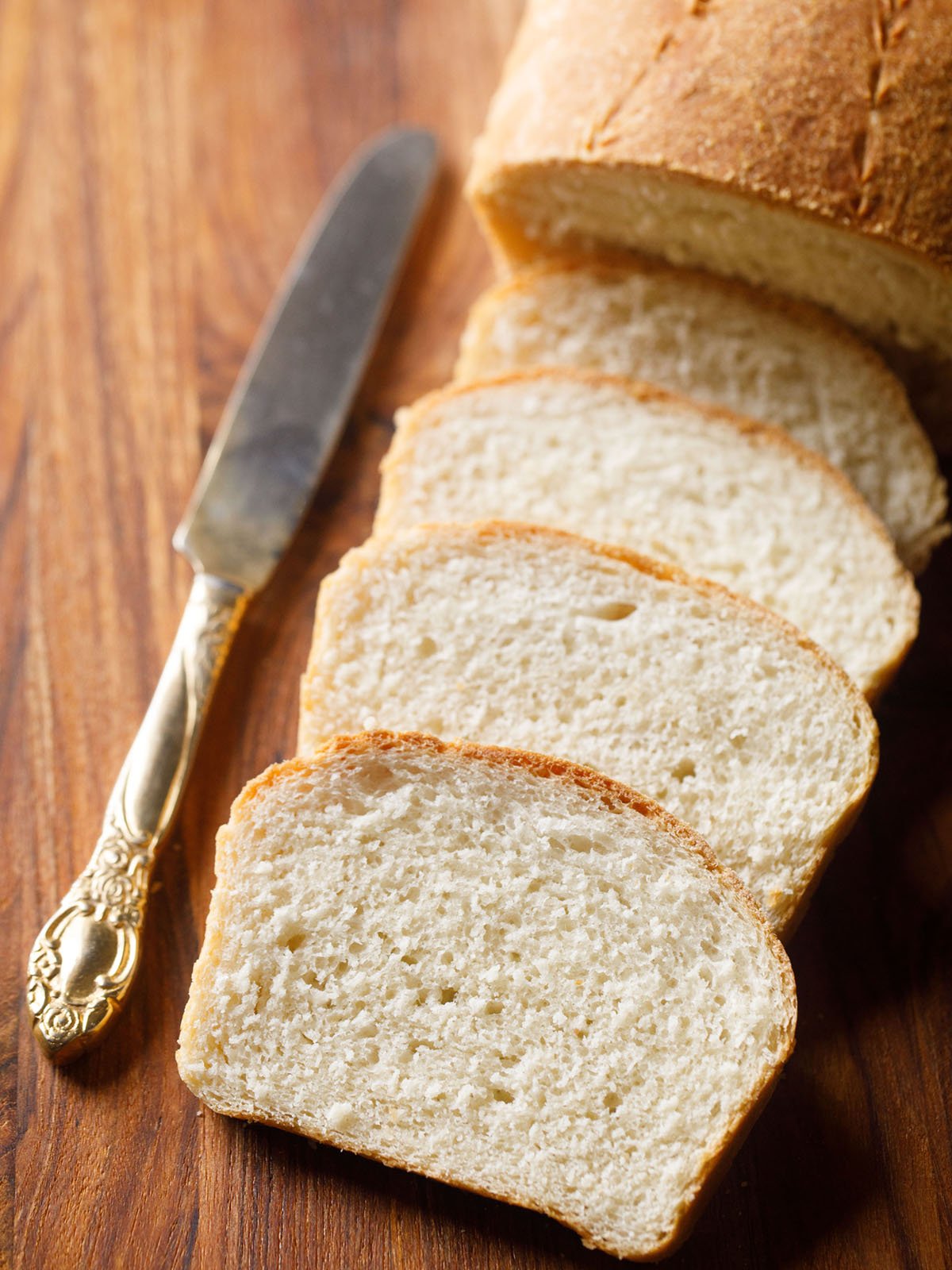
Table of Contents
Why this Bread Recipe Works
I love baking breads at home. The whole process – from making the dough from scratch, kneading with your hands, patiently letting it rise and baking – is terrifically relaxing yet exciting at the same time.
Each loaf is slightly different but brings such joy, both to bake and to eat. And there’s just nothing better than sharing warm, soft slices of homemade bread with your family and friends…Like handing them a piece of your love!
This easy lean bread recipe is great for customizing with additional ingredients. If you want you can add some milk for a softer bread (details in the recipe).
You can also make it into sweet bread by adding extra sugar; or bakes a savory white bread by adding herbs and spices.
Below are steps and photos for making a perfectly fluffy and tender basic loaf of white bread. Give this simple homemade bread recipe a try and you’ll likely fall in love, too.
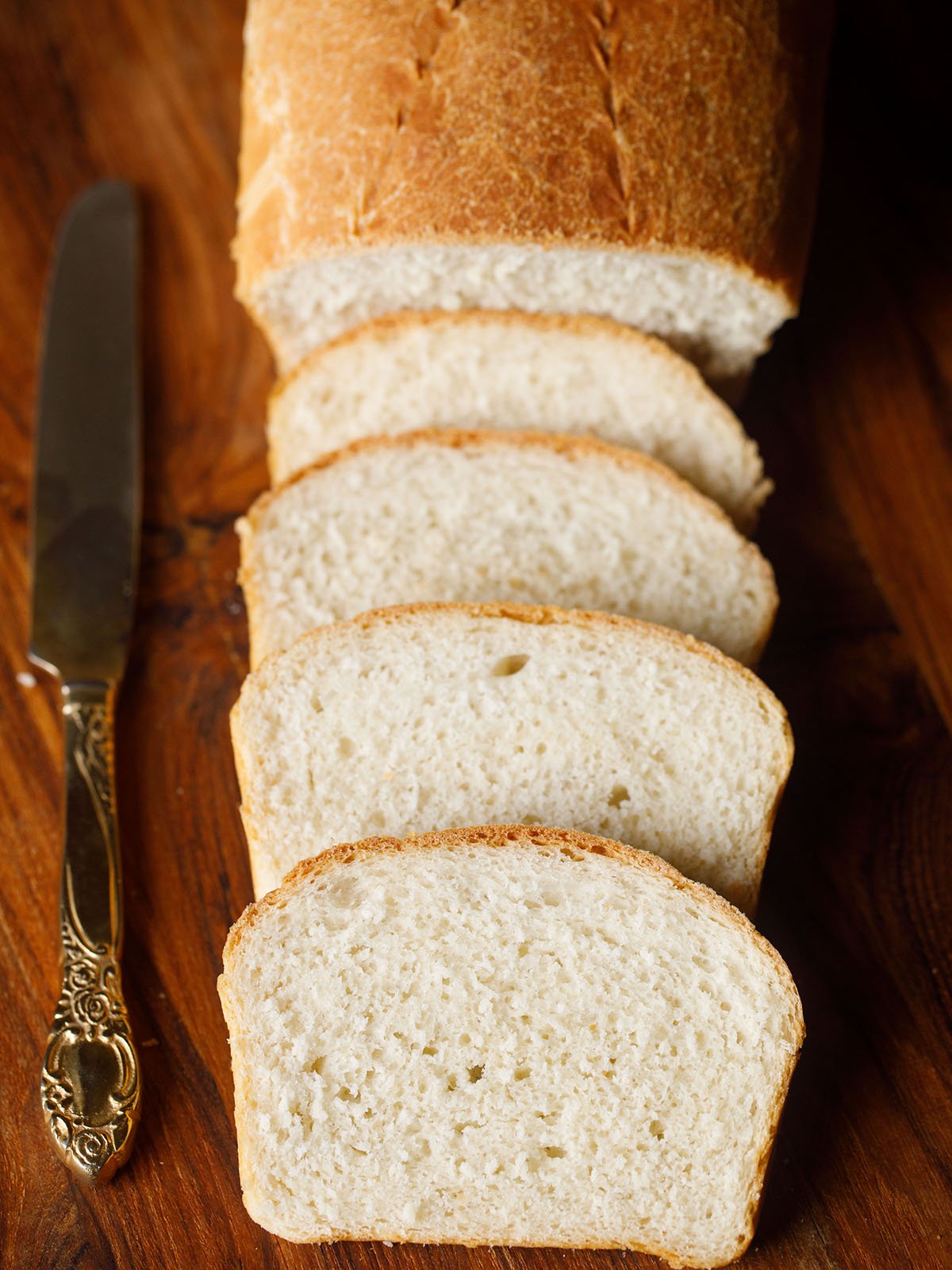
Essential Tips For Any Bread Recipe
While it is a very simple process to make bread from scratch, there are a few key points to keep in mind when you make any bread recipe. You need to follow these pro tips to ensure your loaf is perfect in every way, every time:
- Buy quality ingredients. The best, most delicious bread is made with the best ingredients available. Opt for high-quality flour and yeast, and make sure all ingredients are within the expiration dates. For white breads like these, I recommend unbleached all-purpose flour or bread flour, preferably organic.
- Use warm water. The dry active yeast needs to be treated just rise for the perfect rise. That means it needs to be dissolved in water that is neither hot nor cold but is somewhere in the warm 110-115 degree Fahrenheit (43-46 degrees Celsius). If the water is too cold it won’t activate the yeast, and if it is too hot it will cook the yeast and leave it inactive.
- Kneading: Remember to knead your dough well. If kneading by hand, then spend at-least 10 minutes doing so. The dough has to pass the windowpane test. Take a small portion of the dough and flatten, stretch, spread it into a thin layer. It should not tear or break. You should be able to see through it much like you see through a windowpane.
- Be patient. There will be some periods of resting and waiting while the dough rises and the loaf bakes. Avoid the urge to rush and you will be rewarded with the fluffiest and most tender homemade bread.
- Have fun. Baking bread is all about bringing some warmth and happiness to the house. Bread made with love – or any dishes made with love – simply tastes the best.
See? Simple. Once you perfect the easy, joyful art of baking fresh white bread at home I promise you won’t want store bought loaves again!
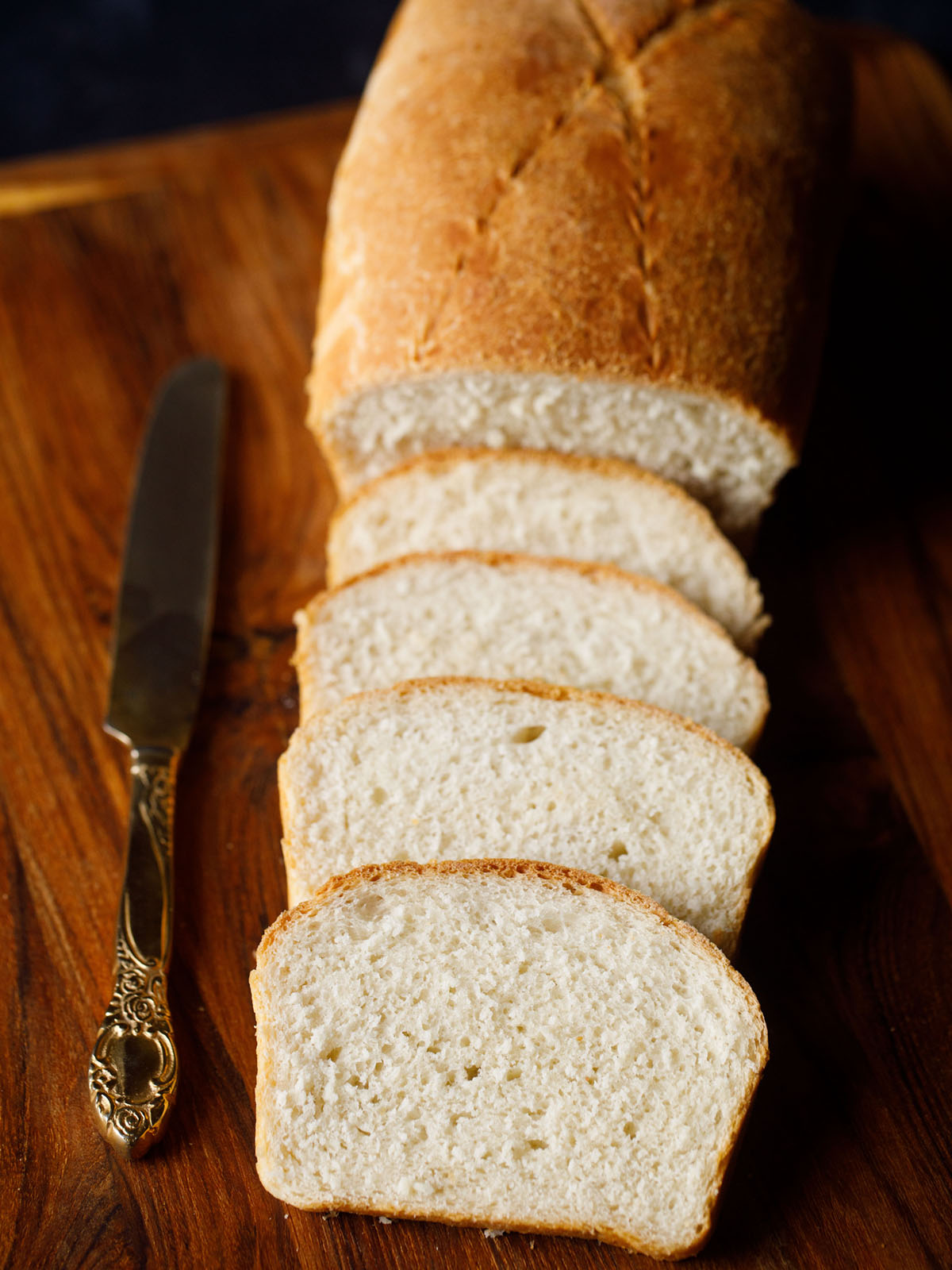
How to make Homemade Bread
Proofing the yeast
1. Take 1 teaspoon instant yeast (rapid rise yeast) or 1.5 teaspoons dry active yeast or 1 tablespoon fresh yeast and 1 tablespoon sugar in a small bowl.
Note: I have used instant yeast which can be directly added to the flour. But I am activating it in warm water just to illustrate to you the method of using dry active yeast or fresh yeast – which always needs to be activated.
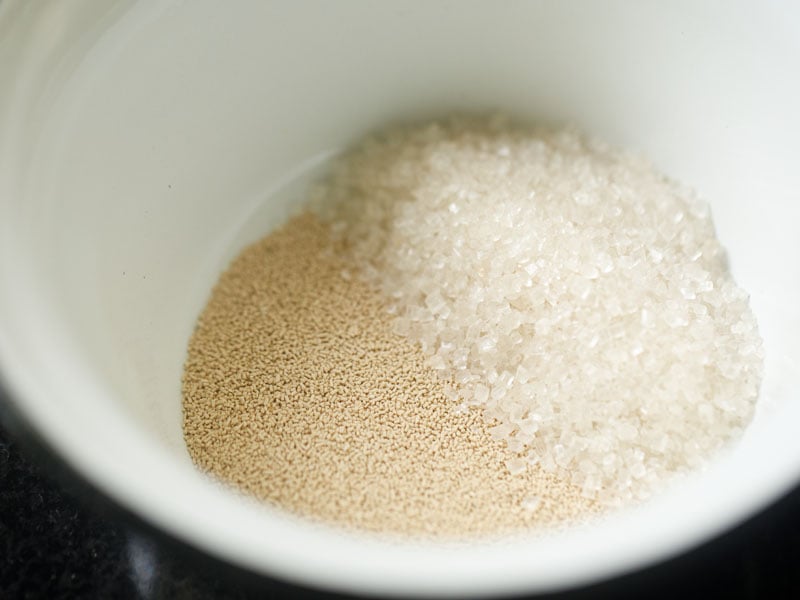
2. Add 1 cup of lukewarm water. Make sure that the water is not hot or cold. The temperature of water should be 41 degrees Celsius (105 to 106 degrees Fahrenheit). Mix it well.
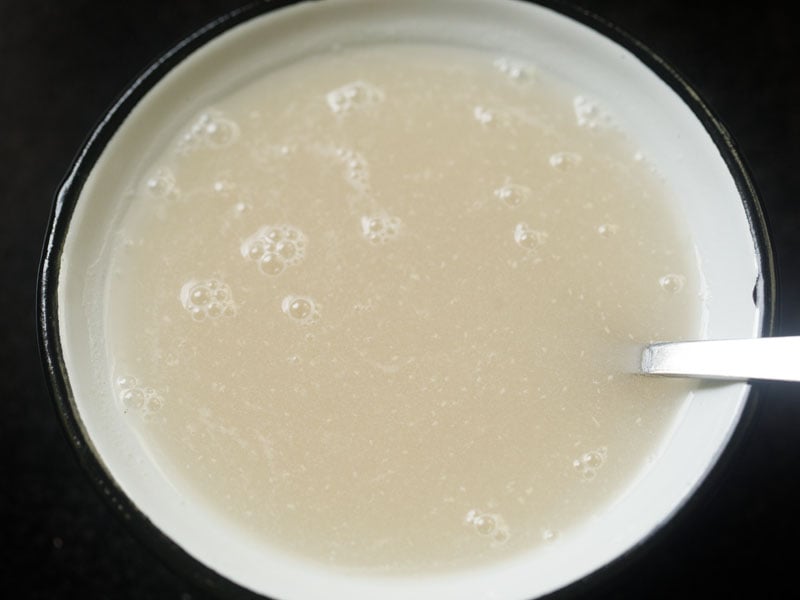
3. Keep in a warm place until the yeast becomes frothy. For instant yeast keep for 5 minutes and for dry active yeast keep for 10 to 15 minutes.
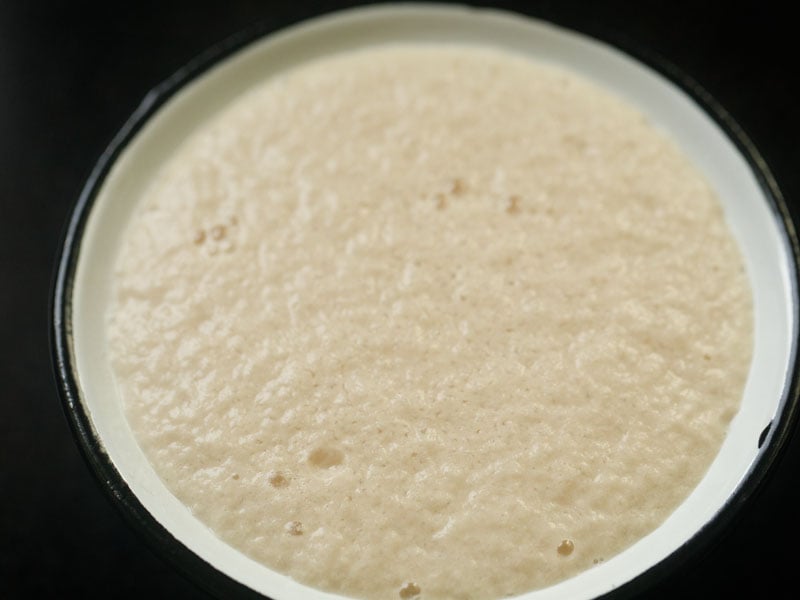
Forming Dough
4. In the meantime take 3 cups of all-purpose flour or bread flour – unbleached or organic (360 grams) and 1 teaspoon salt in a large tray or board or a large bowl. You can also use a stand mixer for kneading dough.
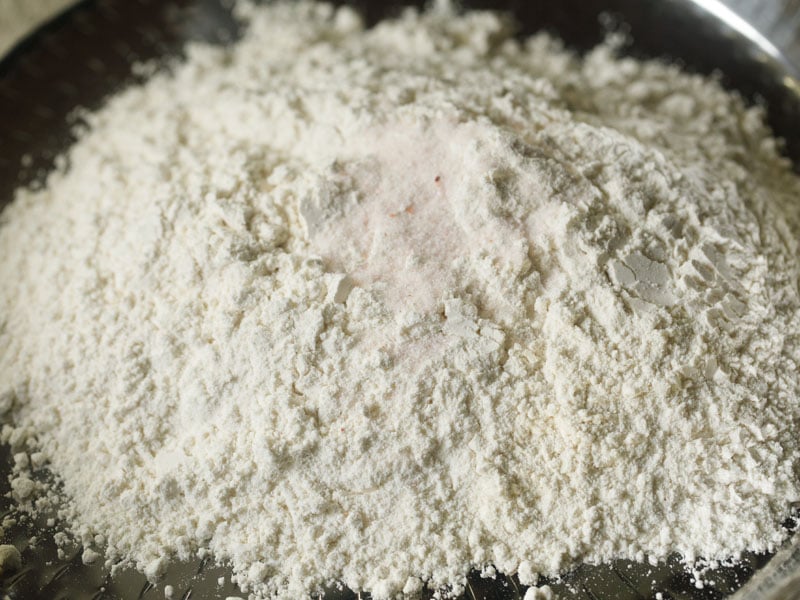
5. Mix well. You can sift the flour with salt if you prefer.
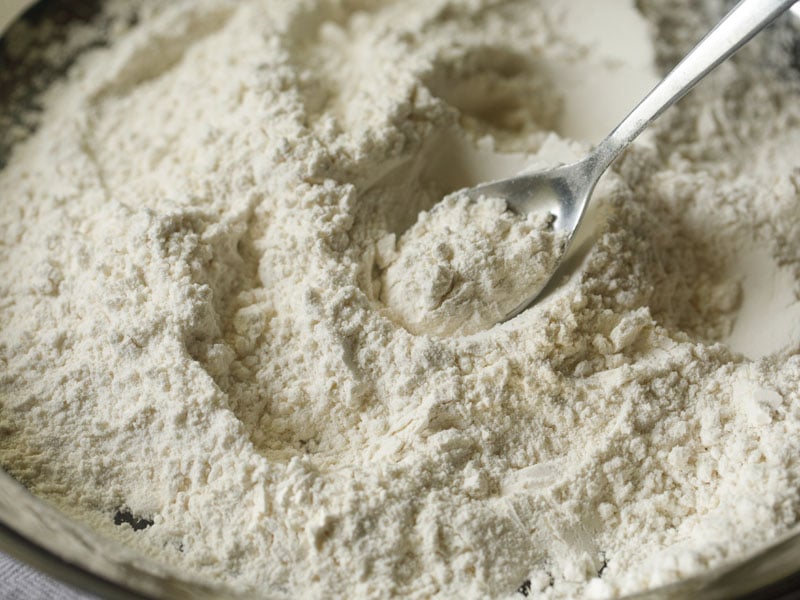
6. Add 1 tablespoon oil – any neutral oil or olive oil. Oil can be swapped for 1 tablespoon butter (dairy or vegan).
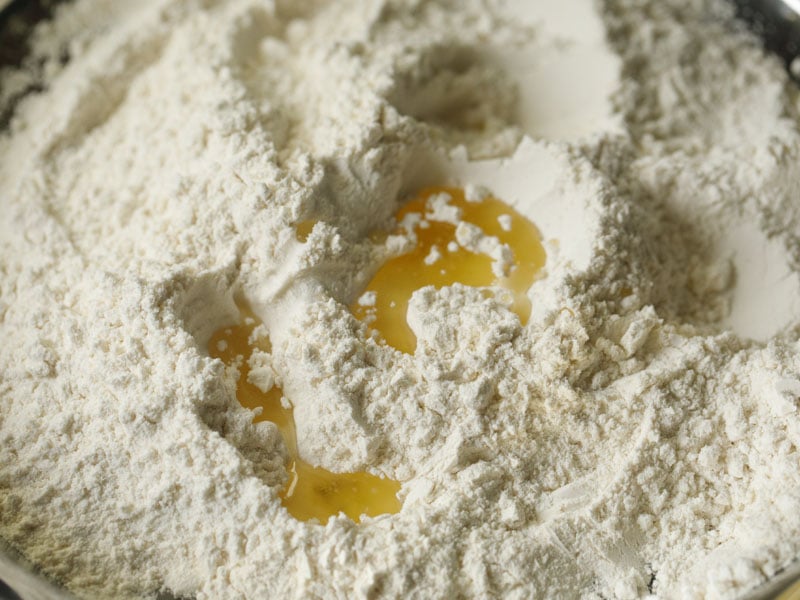
7. Add the frothy bubbly yeast mixture to the flour.
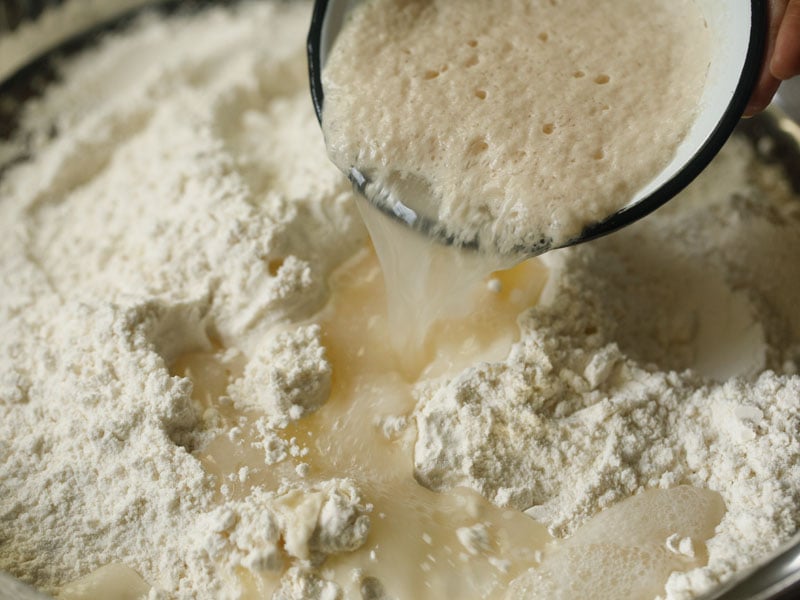
8. Mix with a wooden spoon and you will see that the dough becoming sticky.
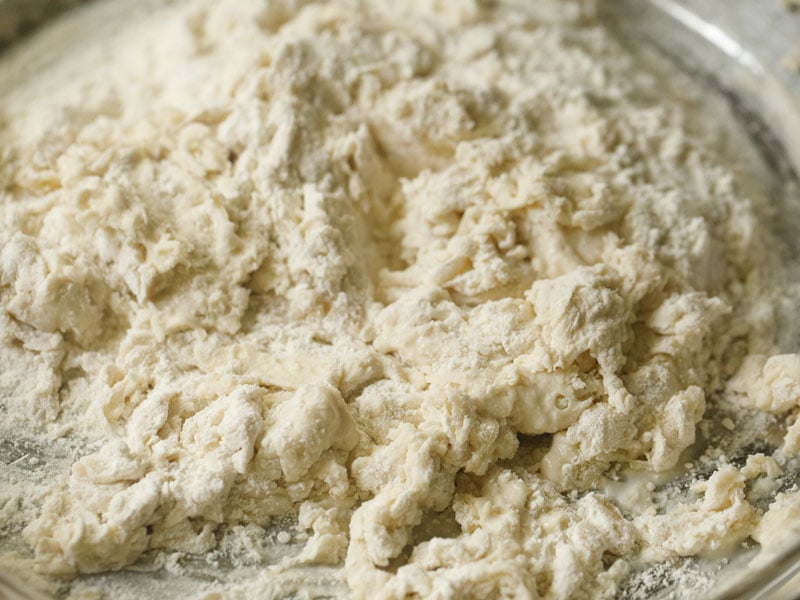
9. Now start kneading the dough for atleast 8 to 10 minutes or until you get a soft smooth, pliable and light consistency.
Tip: If the dough becomes sticky add some flour – mix and knead. If the dough looks floury or dry add a few tablespoons of lukewarm water and knead. Bread flour will need a bit more water than all-purpose flour.
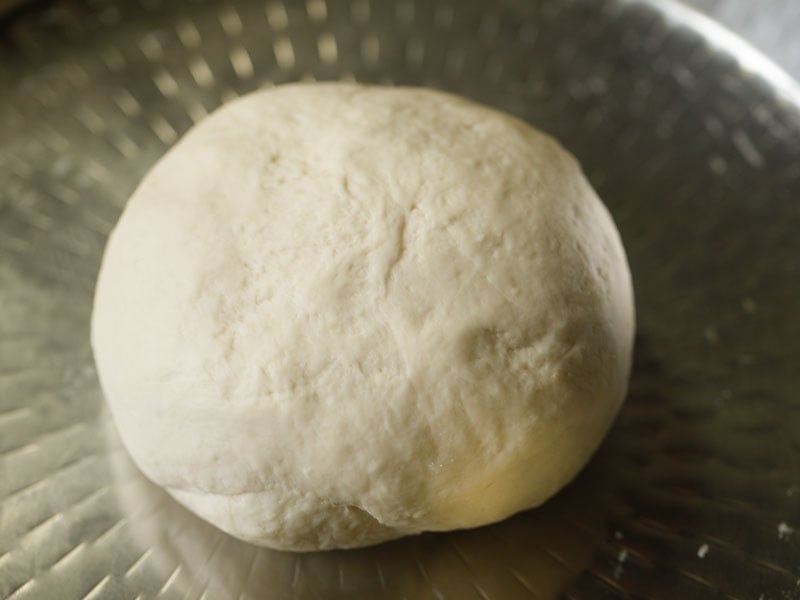
Leavening Dough (First Rise)
10. Cover your bread dough loosely with a large bowl or a kitchen napkin and keep at room temperature to leaven. I used the same plate in which I kneaded the dough. You can brush some oil on the dough prior to leavening it.
- For instant yeast – leaven dough for 45 mins to 1 hour.
- For dry active yeast or fresh yeast– keep for 1.5 to 2 hours.
Tip: A great idea which I follow very often is to leaven the dough using the yogurt settings of your Instant Pot. It works like a charm and so helpful on colder days.
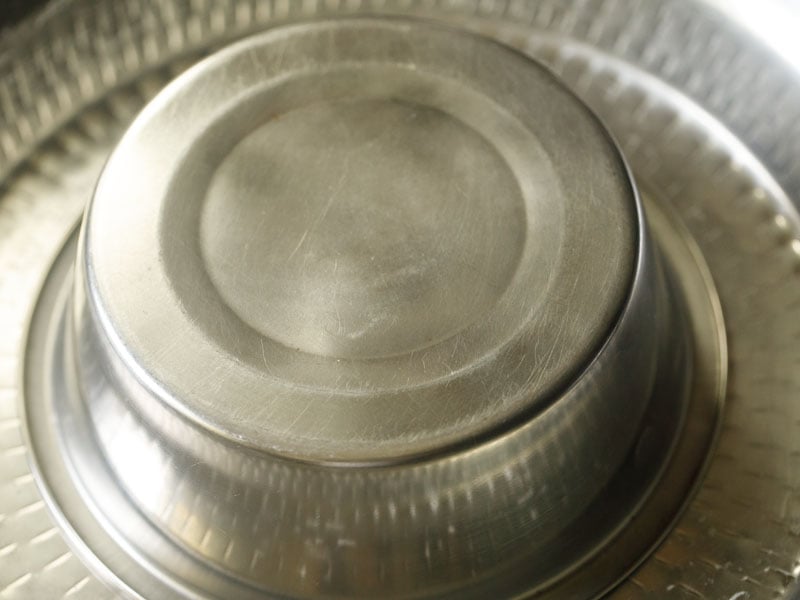
11. After 45 minutes my dough has doubled beautifully.
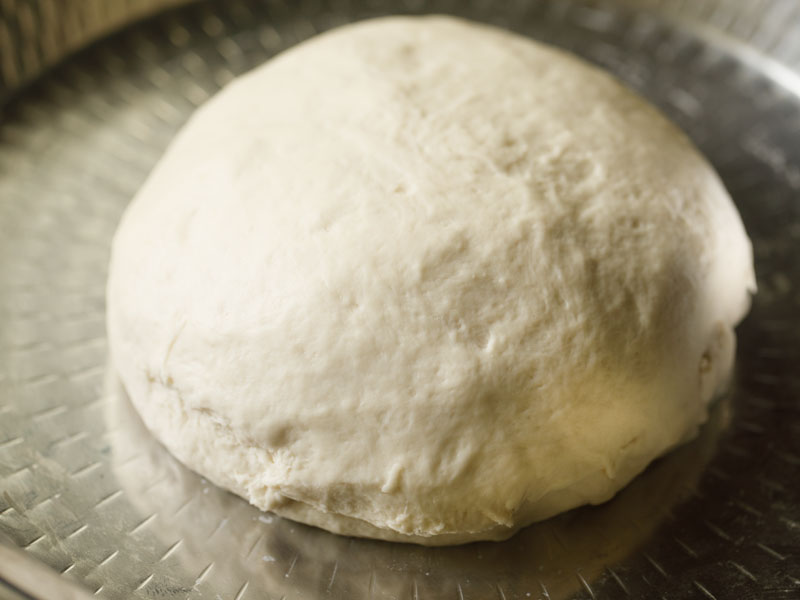
12. Now grease or brush a 9 x 5 inches loaf pan with oil. On a lightly floured surface, lightly knead the dough. This will deflate the dough.
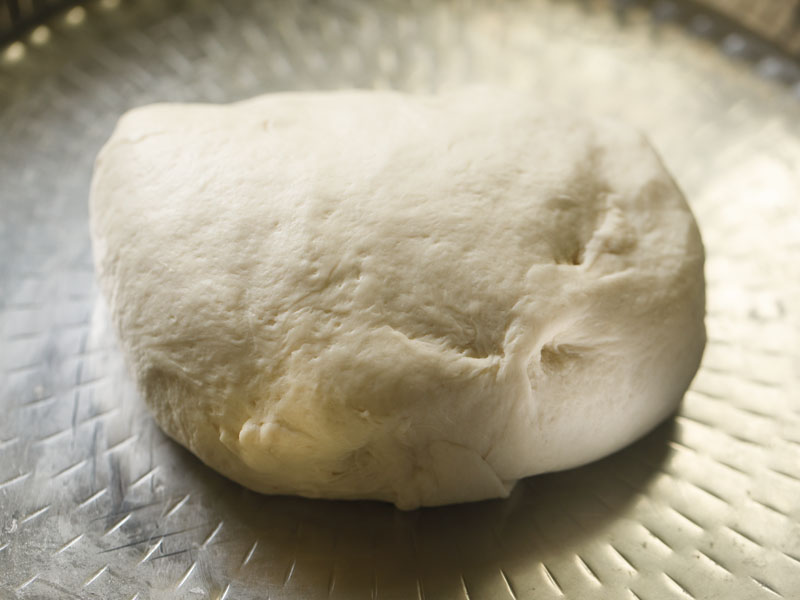
Shaping into a Loaf
13. Flatten the dough with your fingers to a round or square shape. Then begin to roll it.
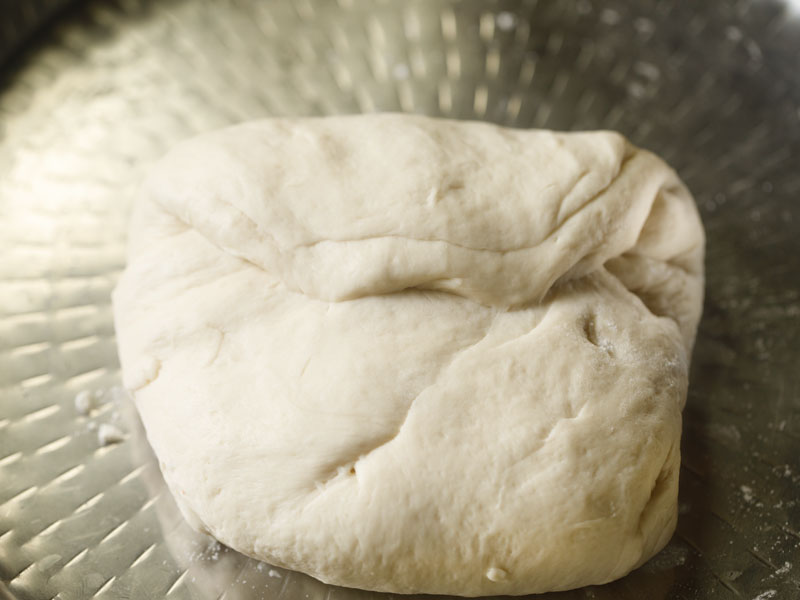
14. Make a neat rolled dough.
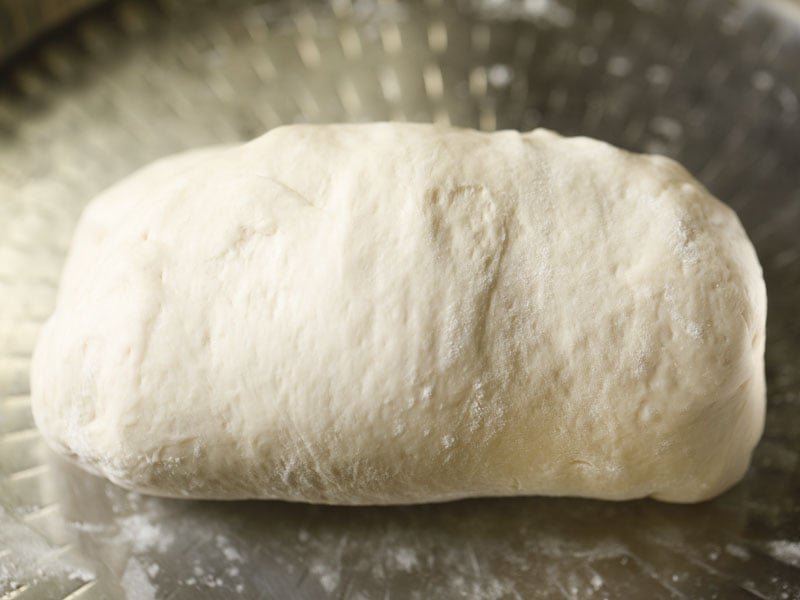
15. The place where the edges meet, join them first. Then press, flatten and smoothen them with your fingers. Smoothen the sides of the loaf as well.
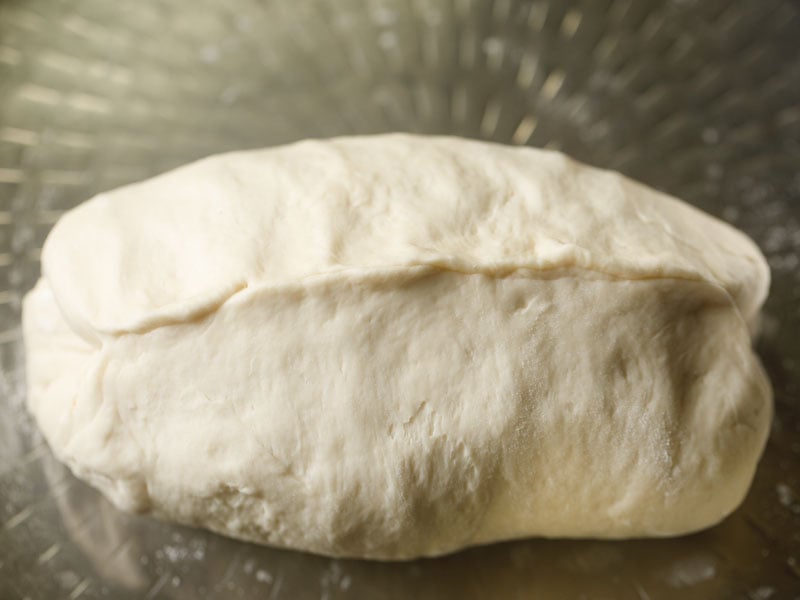
16. Your loaf is ready for the second rise.
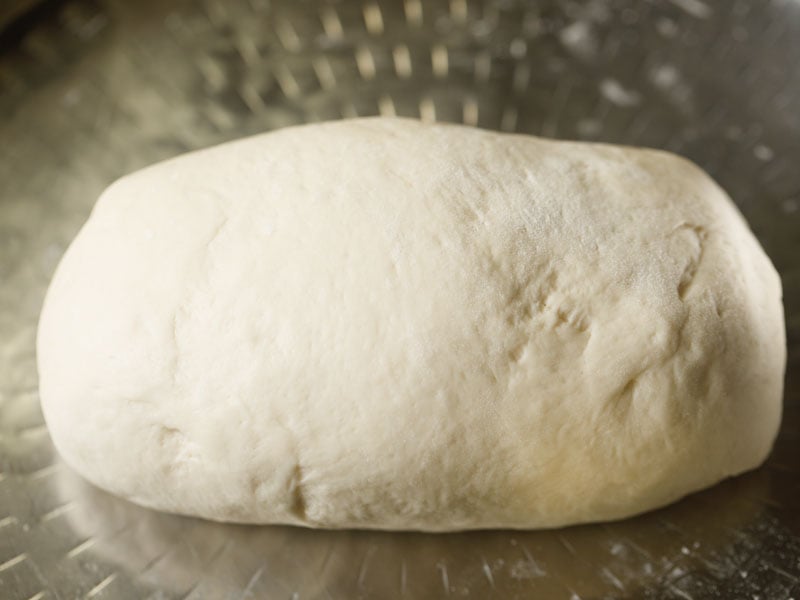
Second Rise
17. Place it in the greased 9 x 5 inches loaf pan with the seamed joined edges touching the bottom of the pan.
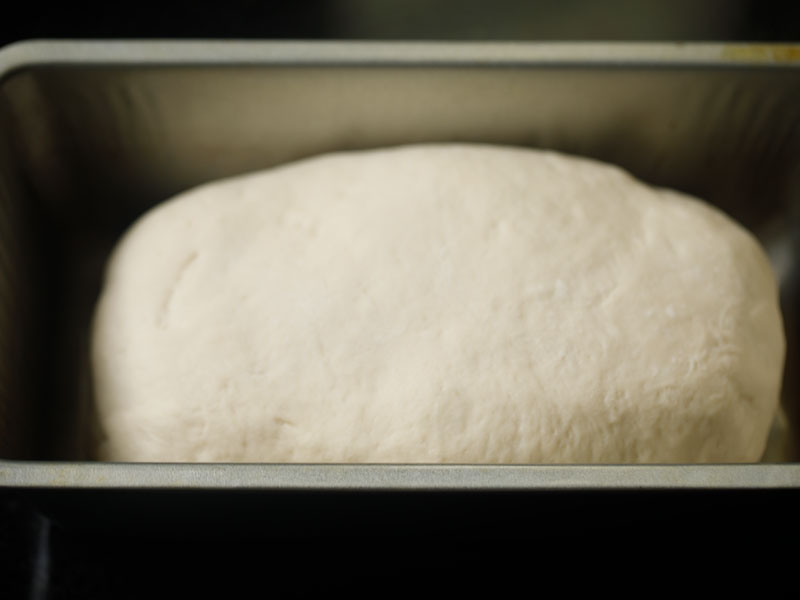
18. Cover the loaf pan with a kitchen towel. Keep it in a warm place.
- If you have used instant yeast – leaven for 20 to 30 minutes.
- For dry active yeast or fresh yeast – set aside for 45 minutes to 1 hour.
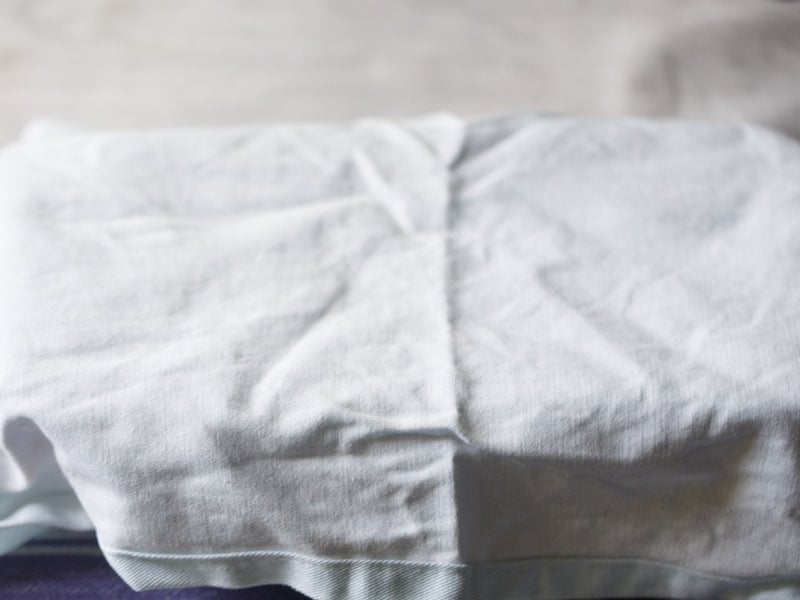
19. The loaf will rise in volume. Remember to preheat your oven 20 minutes prior to baking. Preheat at 190 degrees Celsius (375 degrees Fahrenheit).
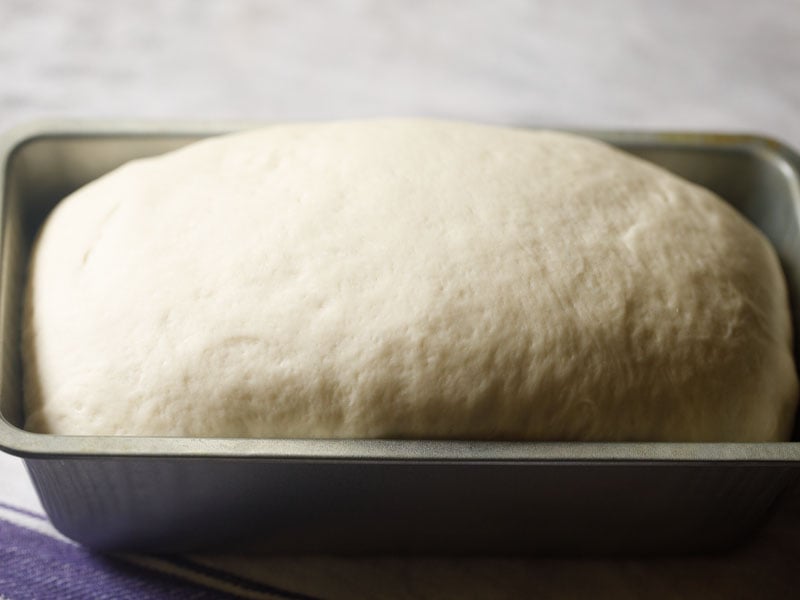
Scoring
20. With a small serrated knife or any sharp knife or a lame, make one long slash or two slashes lengthwise on the center of the dough about ¼ inch deep.
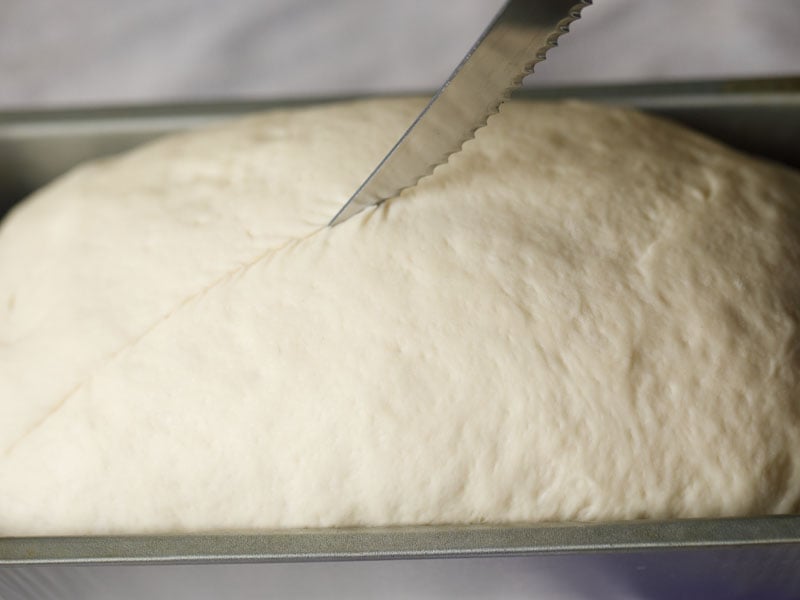
21. Brush the surface with some milk (dairy or vegan). This is an optional step.
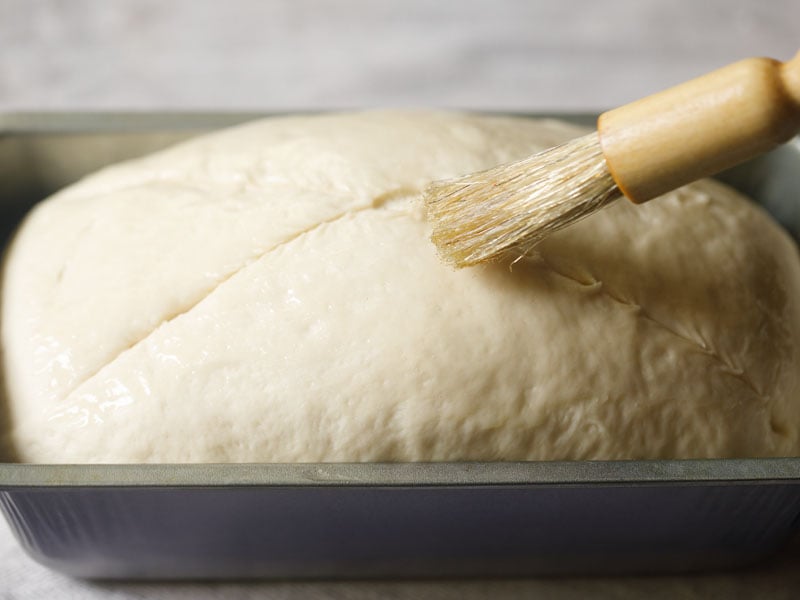
Baking
22. Place the loaf pan in the preheated oven. Bake for 30 to 40 minutes at 190 degrees Celsius (375 degrees Fahrenheit) until the loaf is golden brown. You will also see the sides slightly separated from the pan.
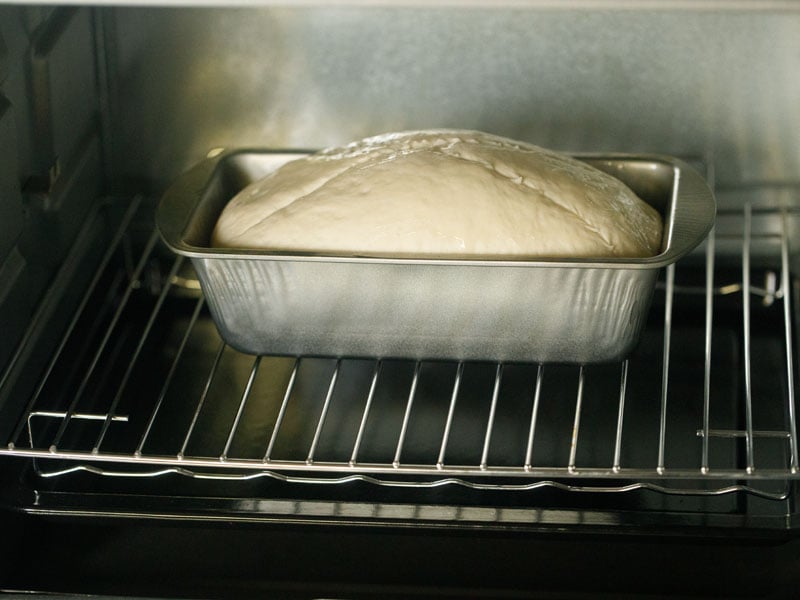
23. In the photo below, you see a lovely loaf of a well baked homemade bread. If your oven browns the surface very quickly, place a parchment paper or aluminium foil on the top of the loaf halfway through the baking – so as to avoid more browning.
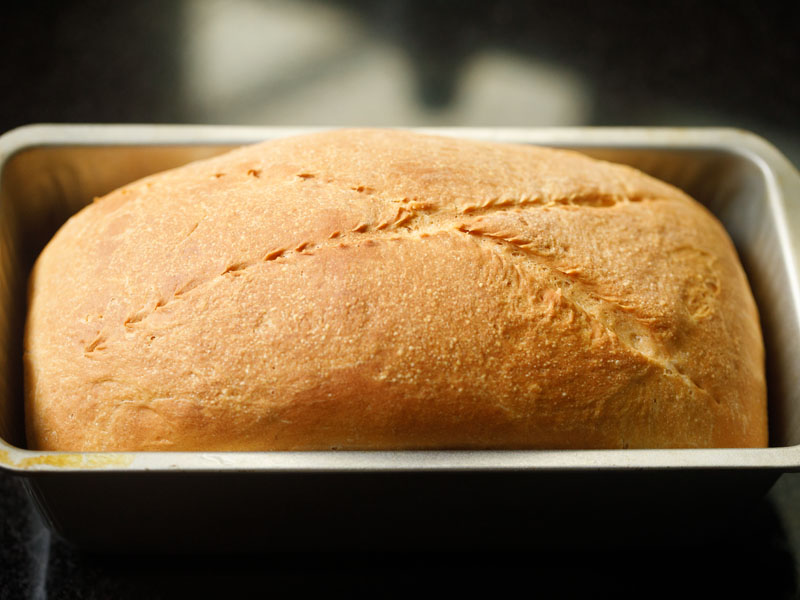
24. Wait for 3 to 4 minutes after the bread is out of the oven. Firstly tap the bread and it should sound hollow – which means that the bread is baked well.
If the bread does not sound hollow, keep it back in the oven to bake for some more minutes.
This is an optional step and you can give it a miss. Remember the bread is hot and so is the pan. Use oven gloves or thick kitchen towels to remove the bread from the pan.
Lift one end of the white bread to check for an even browning at the bottom. If the bottom of the loaf is pale, then keep it directly in the oven (without the pan) for 5 more minutes and bake.
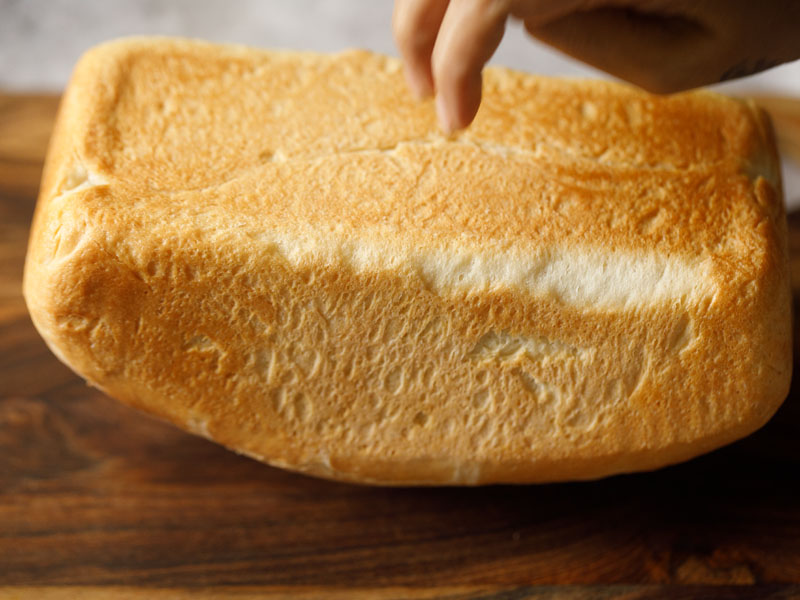
25. Transfer the loaf from the pan immediately and keep it on a wired rack. If you keep it inside the pan, the bottom will get soggy. Let the loaf cool at room temperature on the wired rack or tray.
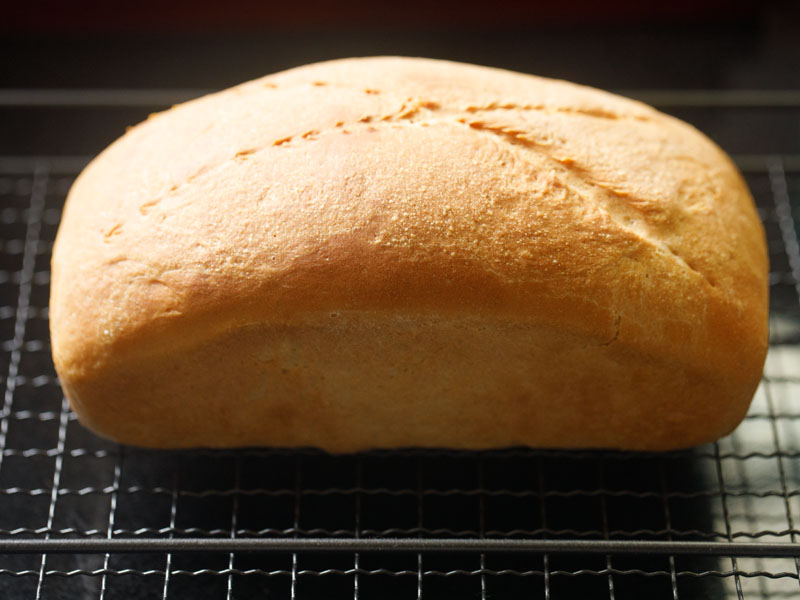
26. Enjoy homemade bread with your favorite curry or soup or just making one of your favorite sandwiches or toast.
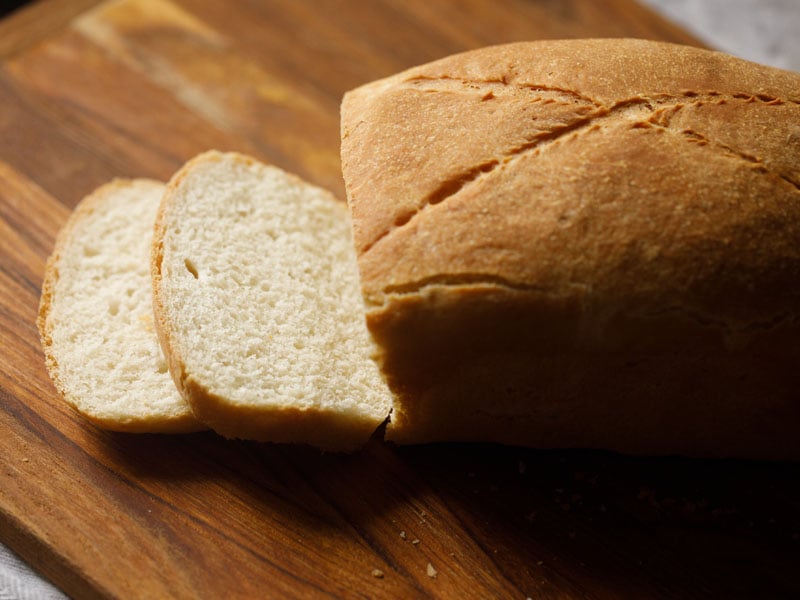
Serving Suggestions
Enjoy slices of warm, freshly baked white bread plain or with a smear of soft butter or lightly toasted in ghee.
Serve toasted bread with jams or topped with slices of avocado, or a tablespoon of peanut butter or preferred nut butter for a yummy snack.
Homemade bread is great for making sandwiches – the only limit is your imagination! Check out my collection of 40 Best Sandwich Recipes for some ideas to get started.
Storage
Place the bread in a bread box or a covered box and refrigerate for a week. At room temperature, it keeps well for 2 to 3 days. You can also freeze it for a couple of months. Thaw before using or defrost it in the refrigerator overnight.
Expert Tips
- Variations: You can divide the dough into parts and make dinner rolls. Add some herbs (fresh or dried) to make a fragrant herb bread. Replace water with milk (dairy or vegan) for a milk bread. Include some more sugar or nuts, berries, dry fruits for a sweet bread.
- Kneading: You can knead the dough with hands as I have done. If you have a food processor or a stand mixer, then knead the dough in these.
- Baking: Since no two ovens are the same, it can take less or more time for the bread to bake in your oven. If the top surface of the bread browns quickly in your oven then place an aluminum foil or parchment paper on the top. This stops the bread from getting browned more.
- Yeast conversion: Make this bread recipe easily with any kind of baking yeast that you have. Follow this yeast conversion: 1 teaspoon instant yeast = 1.5 teaspoon active dry yeast = 1 tablespoon fresh yeast.
- Scalable recipe: Make a large batch of 2 to 3 loaves by easily scaling this recipe.
FAQs
To keep the bread soft I recommend that you store in an airtight bag or a bread box and keep at room temperature for up to 2 to 3 days.
Yes, white bread is great for freezing. Place in an airtight bag or a covered container and store in the freezer for up to 2 to 3 months. Allow the bread to defrost in the refrigerator overnight before enjoying.
Divide the dough into equal parts and bake for individual dinner rolls or Pav.
Substitute all-purpose flour with your favorite gluten free substitute for an easy GF-friendly white bread recipe.
More Bread Recipes You Can Try!
Bread Recipes
Bread Recipes
Bread Recipes
Bread Recipes
Please be sure to rate the recipe in the recipe card or leave a comment below if you have made it. For more vegetarian inspirations, Sign Up for my emails or follow me on Instagram, Youtube, Facebook, Pinterest or Twitter.
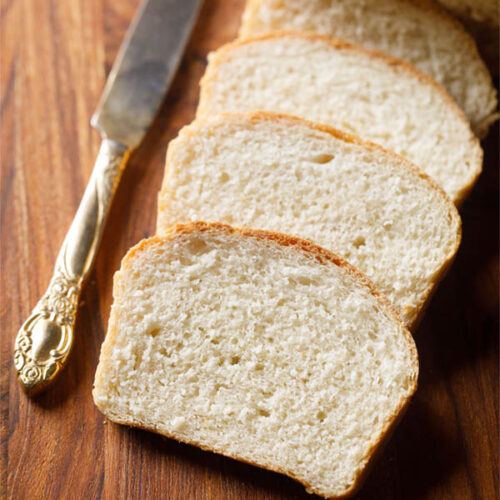
Bread Recipe | White Bread
Ingredients
- 3 cups all-purpose flour or bread flour (preferably unbleached), 360 grams
- 1 cup water (lukewarm)
- 1 teaspoon instant yeast or 1.5 teaspoon dry active yeast or 1 tablespoon fresh yeast
- 1 tablespoon sugar
- 1 tablespoon oil neutral flavored oil or olive oil
- 1 teaspoon salt or add as required
- 1 to 2 tablespoons milk (dairy or vegan) – for brushing, optional
Instructions
Proofing yeast
- In a small bowl take the instant yeast or dry active yeast and sugar. Add lukewarm water.
- Mix well and set aside until the yeast activates. For instant yeast keep for 5 minutes and for dry active yeast keep for 10 to 15 minutes.
Preparing dough
- While the proofing is happening, sieve or mix the flour with salt.
- Add the oil and the frothy yeast mixture to the flour.
- With a wooden spoon mix everything.
- Now use your hands and knead the dough for about 8 to 10 minutes. The dough has to be smooth, soft and light.
- If the dough looks sticky, then add a few tablespoons of flour and knead. If the dough looks dry or floury, add a few tablespoons of lukewarm water and continue to knead.
- Keep in a large bowl and cover loosely with kitchen napkin.
First Rise
- Set aside until the dough doubles up.
- For instant yeast – leaven dough for 45 mins to 1 hour. For dry active yeast or fresh yeast – keep for 1.5 to 2 hours.
- If needed set aside for some more minutes until the dough has doubled up nicely.
Shaping into a loaf
- Grease or brush a 9 x 5 inches loaf pan with oil.
- Take the dough on a lightly floured surface and gently knead. This will deflate the dough.
- Flatten the dough with your fingers to a round or square shape. Then begin to roll it neatly.
- The place where the edges meet, join them first. Then press, flatten and smoothen them with your fingers. Smoothen the sides of the loaf as well.
- Place in the loaf pan with the seamed joined edges touching the bottom of the pan.
Second rise
- Cover again loosely with the kitchen napkin and let it rise again for until fully doubled.
- If you have used instant yeast – leaven for 20 to 30 minutes. For dry active yeast or fresh yeast – set aside for 45 minutes to 1 hour.
- Preheat the oven to 190 degrees Celsius (375 degrees Fahrenheit) for 20 minutes prior to baking.
- With a small serrated knife or any sharp knife or a lame, make one or two long slashes lengthwise on the center of the dough about ¼ inch deep.
- Brush the surface with some milk – dairy or vegan. This is an optional step.
Baking
- Place the loaf pan in the oven. Bake for 30 to 40 minutes at 190 degrees Celsius (375 degrees Fahrenheit) until you see a golden crust.
- If your oven browns the surface very quickly, place a parchment paper or aluminium foil on the top of the loaf halfway through the baking – so as to avoid more browning.
- Wait for 3 to 4 minutes after the bread is out of the oven. Tap the bread and it should sound hollow – which means that the bread is baked well. If the bread does not sound hollow, keep it back in the oven to bake for some more minutes.
- Transfer the loaf from the pan immediately and keep it on a wired rack. If you keep it inside the pan, the bottom gets soggy. Let the loaf cool at room temperature on the wired rack or tray.
- Now enjoy your homemade bread with your favorite curry or soup or just making one of your favorite sandwiches or toast.
Storage
- Place the bread in a bread box or a covered box and refrigerate for a week. Or you can freeze it for a couple of months. Allow the bread to defrost in the refrigerator overnight before serving.
Video
Notes
- Variations: You can divide the dough into parts and make dinner rolls. Add some herbs (fresh or dried) to make a fragrant herb bread. Replace water with milk (dairy or vegan) for a milk bread. Include some more sugar or nuts, berries, dry fruits for a sweet bread.
- Kneading: You can knead the dough with hands as I have done. If you have a food processor or a stand mixer, then knead the dough in these.
- Baking: Since on two ovens are the same, it can take less or more time for the bread to bake in your oven. If the top surface of the bread browns quickly then place an aluminum foil or parchment paper on the top. This will avoid further browning while baking.
- Yeast conversion: Make this bread recipe easily with any kind of baking yeast that you have. Follow this yeast conversion: 1 teaspoon instant yeast = 1.5 teaspoon active dry yeast = 1 tablespoon fresh yeast.
- Scaling: You can halve or double the recipe and make a small or large batch of homemade bread.
Nutrition Info (Approximate Values)
This Bread recipe from the blog archives first published in April 2012 has been updated and republished on April 2023.
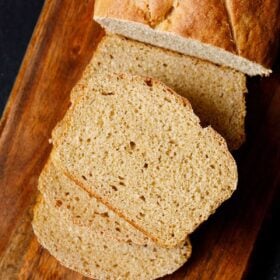
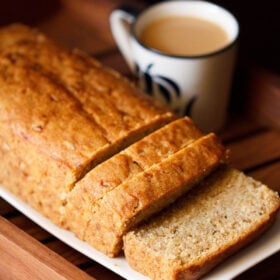

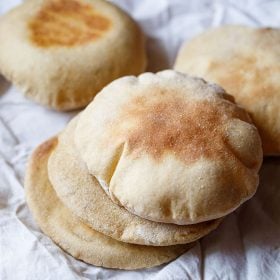








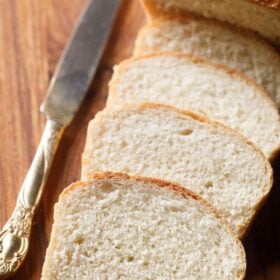
Hi Dassana,
I am a fan of your blog and it is my first go to place when in doubt.
Tried making whole wheat bread in the past and white bread today, in both cases the dough rose very well, and had a beautiful crust on baking: however the loaf was dense and doughy on the inside both times, even after baking it for an extra 20 mins. What could have gone wrong?
Can’t wait to try again, but will wait for your reply before i do. Thanks in anticipation 🙂
thanks girish. dense loaf can be due to yeast not proofing well or the quality of yeast. second not kneading the dough very well. if kneading with hands, then the dough has to be kneaded for 8 to 10 minutes. for yeast quality, you can buy a good brand of yeast like red star, mauripan/gloripan or you use fresh yeast, which is available in bakeries. but for fresh yeast the amount to be added will be more as compared to dry active or instant yeast. most of the times when the bread becomes dense, its the yeast proofing which is at fault. but since you mention that the dough had risen well, i am doubting if it is the yeast. if the proofing is done well, the dough also rises well. also try adding some more water while kneading. a faint slightly sticky dough is fine.
Hi,I followed your white bread recipe and it turned out fine as you described. I’d probably add another tsp of salt to suit my taste next time I make this bread. I used instant dry yeast.Thanks for the recipe.
welcome reen and thanks. salt can always be added less or more depending on one’s taste preference.
Hello mam, whenever I use milk (3/4cup milk and 1/4cup water to proof active dry yeast) dough proofing is very slow and less especially the 2nd raise., whereas when I use water alone the dough proofing is good. So should I use more yeast if using milk? Kindly reply.
there is no need to use milk for proofing. you can add milk when kneading the dough. i have never used milk for proofing yeast, so i am not aware about it being slow. i always use water. if more yeast is used, then the bread gets a too much yeasty aroma and sour taste.
No mam, I used only water to proof the yeast. I used 1/4cup water to proof the yeast., and then directly added 3/4cup milk while kneading the dough. I didn’t use milk to proof the yeast.
okay benny. did you use warm milk or cold milk or milk at room temperature. its best to use milk at room temperature or lukewarm milk. if cold milk is added, it will affect the yeast multiplication in the dough.
Hi dassana..i tried your bread recipes and it comes out very well…one thing what you said is correct…once we start to make homemade breads ..we wil not feel to buy store bought breads..thanks to you that now in my home we have a chemical free bread
thank you savitha for the feedback. homemade breads are so better than the store brought ones. even a simple white bread like this one is much better than the store brought white bread.
Very good recipe really
Thanks Susrita
hi mam, this is benny from chennai. Hope u remember me. Already I have commented on your paneer-butter-masala recipe. made this white bread and it came out well. And also saw your link for making whole wheat bread and the secret tip u gave to make it softer. So next I’m planning to try that also since it’s healthier than white bread. your blog helps even men to cook easily. All your recipes are so easy to follow that even a 10yr old can make it. Will share the results after making whole wheat bread. Thank you very much. bye for now.
surely share your feedback 🙂 once you make the whole wheat bread. thanks for your kind, encouraging words and positive views. you are welcome.
I tried this today…. it became too hard… outside crust was perfect but from inside it was just like a dough??? what to do?
shona, looks like the yeast did not proof well, hence the inside had a doughy texture. white bread is one of the most easiest breads to make. the only key point is that the yeast should proof well. if the yeast does not proof well or does not proof at all, then always throw the solution and start again. if the water is too hot, the yeast cells die. if the water is on the cooler side, the yeast cells do not get activated. a properly proofed yeast will help in leavening the bread well.
Hi, Dassana! I would love to try this recipe but can I use bread flour instead of maida? will it change anything else in the recipe? Please advice.
Siyamala, yes you can use bread flour. just add water as required.
I am new to baking..after using my microwave for 5 yrs for purely reheating food ..I finally made bread today..it came out perfect. Thanks 🙂
welcome always nimmo, thanks for positive views on white bread recipe 🙂
Hi Amit
So well you have described the process with pics. Thank you .
I am planning to buy Panasonic bread maker and would like to know if anyone has used bread maker
Also can we use our normal chapati atta for the flour.
Can you help please?
thanks ram. i have never used a bread maker, so i cannot comment on how it is or its advantages or uses. but i have heard bread makers are good for bread making. you can use normal chapati atta, but with chapati atta, the bread texture becomes dense. you can check this recipe on whole wheat bread on the blog, where the texture is light and soft, due to using vinegar or curd in the dough.
you can also use half-half or 2:1 proportion of atta flour & maida respectively.
Thank you Amit for your quick response
I will try adding vinegar or curd as you have described
Can we add gluten powder instead?
you can add gluten powder instead of vinegar and curd.
Hi mam,
I tried ur white bread recpie but instead of loaf i made cinnamon rolls amd garlic rolls which were perfect..second tine i made loaf with the same. Recpie but d bread was crumbley and crust was very hard.third i prepared stuffes mozorella chesse and sauted onions with corns and shaped like dominos garlic bread..it was also perfect..dont know what is the provlem wiyh loaf??
could be that more moisture/water was required in the dough. crumbliness could be due to not kneading the dough properly or less moisture. since a loaf is the entire dough being baked at once, try kneading very well and let the dough be soft, smooth and pliable.
hi can we bake this bread in any aluminium pan like rectangular cake pan or we must bake in a bread loaf pan alone? and i kept the dough for rising for 2hrs even though it doubled in 1hr.is this could be the reason for the dense bread i got after baking?please clarify?bread was not very soft and little bit crumbling.
krithika, if making in a round pan, the structure and the shape of the bread can go awry. instead of spreading the dough completely in the pan, you can make small to medium sized buns and then place them in the pan leaving some space between them. dense bread is mostly due to yeast proofing not done well or quality of yeast. in a warm and humid climate, the dough can rise quickly.
i have posted my doubts once again i dont know what happened to my previous posts?if it is a long post it wont appear?clarify my doubts regarding yeast smell, the pan to be used,if the dough increases in one hr is that enough,and can i insert a toothpick to check the bread ,i want to try once more.sorry for bothering u with too many questions.
harini, not received any of your queries. nothing like if its a long comment, it won’t appear. its alright, you can ask too many queries 🙂
1. yeast smell depends on the quality of yeast. sense of smell is relative and for some there can be a sensitivity to the aroma of yeast.
2. the rise of the dough depends on the temperature. in a hot and humid temperature, the dough will rise first. so if the dough has risen well, then its fine.
3. you can try with a toothpick. i always knock on the loaf and only when i hear a hollow sound, i remove the loaf from the pan.
If using instant yeast
Then should v add 1/2 tbsp or only 1 tsp ?? Directly in flour
Pls help ṭhank you
i have mentioned the amount of instant yeast in the notes section of the recipe card. its 1 teaspoon instant yeast. if using instant yeast, either you can add directly in flour and knead everything together. or dissolve the yeast in water + sugar solution and then add. but do be sure that it is instant yeast. i have seen a few packets in india where it is actually dry active yeast but labelled as dry instant yeast. both are different.
hi, forgot to tell this. the yeast i used is good it frothed like urs in the picture.
harini, not received your previous comment related to this one. let me know what happened.